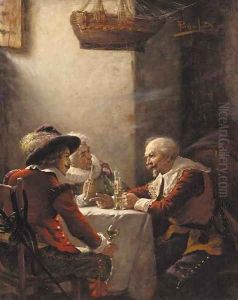Alois Priechenfried Paintings
Alois Priechenfried was an Austrian painter known for his genre paintings, portraits, and still life artworks. Born on August 27, 1867, in Linz, Austria, he was part of a family with artistic roots; his father, Alois Heinrich Priechenfried, was also a painter. At a young age, Alois was exposed to the world of art, which influenced his decision to pursue a career in the same field.
He studied at the Academy of Fine Arts in Vienna under the guidance of Christian Griepenkerl, a respected professor and historical painter. After completing his education, Priechenfried focused on genre painting, which depicted scenes from everyday life with an emphasis on the human figure. His works often featured detailed interior settings, highlighting the domestic life of the period. In addition to genre scenes, he also painted portraits and still lifes, which exhibited his skill in capturing the textures and subtleties of various objects.
Throughout his career, Priechenfried's style was characterized by its fine detail, vivid color palette, and the clarity of his compositions. His paintings often evoked a sense of nostalgia and were appreciated for their storytelling qualities. He exhibited his work in various art shows and gained a reputation for his expertise in genre scenes.
Alois Priechenfried lived through a period of significant change in the art world, with the emergence of modernist movements that challenged traditional academic art. However, he remained committed to his style, which was rooted in the 19th-century European painting tradition. He continued to work and exhibit his art into the 20th century.
Priecehnfried's work has been displayed in numerous galleries and is part of private and public collections. Although he may not be as widely recognized as some of his contemporaries, his paintings have been appreciated by collectors and art enthusiasts for their charm and historical value.
He passed away on October 14, 1953, in Vienna. Alois Priechenfried's legacy lives on through his paintings, which continue to be studied and admired for their craftsmanship and portrayal of the social customs of his time.
